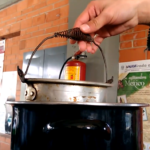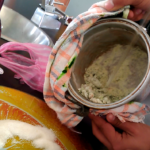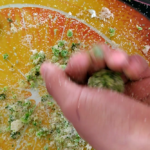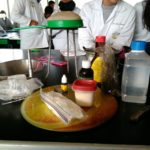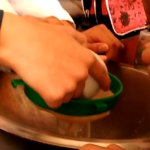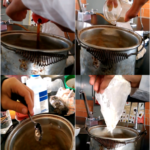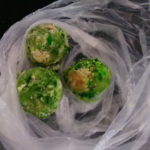Agropecuarias y de Alimentos
Goma de mascar con proteína a base de insectos.
- Categoría: Pandilla Juvenil (1ro. 2do. y 3ro. de nivel Secundaria)
- Área de participación: Agropecuarias y de Alimentos
- Asesor: MARISA CALLE MONROY
- Equipo [ ]: Gabriel Flores Franco(Chichen-itzá) , Ethan Mier Estrada(Chichen-itzá) , Uriel Tonatiuh Luna Méndez(Chichen-itzá)
Resumen
El chicle es conocido por sus beneficios para combatir el mal aliento. Por eso la idea de poder beneficiar con proteínas en un chicle, estas proteínas las podemos obtener de grillos y chapulines, ya que comer grillos es considerado el alimento del futuro porque contienen muchas proteínas, carbohidratos, calcio, vitamina B12 y magnesio.
Mientras tanto los chapulines también presentan muchos beneficios porque ayudan a la digestión y contienen una gran cantidad de vitamina A, B y C, minerales, calcio, zinc y magnesio B.
Por otro lado, ayuda eficazmente a concentrarse y favorece la memoria en la medida en que oxigena eficazmente el cerebro. Los beneficios del chicle no se quedan ahí, en efecto, mascando chicle con tranquilidad ayuda al organismo a soportar mejor, el estrés, y también calma los nervios. También es eficaz para relajarse ante un problema complicado.
Las proteínas por sus propiedades fisicoquímicas, se pueden clasificar en proteínas simples y proteínas conjugadas. Las proteínas son necesarias para la vida, sobre todo por su función plástica (constituyen en el 80% del protoplasma deshidratado de todas las células) pero también por sus funciones biorreguladoras. A sí mismo, las proteínas de grillo contienen a aminoácidos esenciales.
Los chapulines tienen la capacidad de arrasar cosechas. Recolectarlos resuelve un gran problema. Salva a los cultivos que están expuestos a la plaga.
Pregunta de Investigación
¿Cómo elaborar una goma de mascar con proteína a base de grillo y chapulín?Planteamiento del Problema
El chicle presenta muchos beneficios sobre la salud. En efecto, más de la mitad de las personas que mascan chicle confiesan recurrir a esta golosina para refrescar el aliento. Por otro lado ayuda eficazmente a concentrarse y favorece la memoria en la medida en que oxigena eficazmente el cerebro.
Los beneficios del chicle no se quedan ahí, en efecto, mascando chicle con tranquilidad y de forma regular, se ayuda al organismo a soportar mejor el estrés, y también calma los nervios. También es eficaz para relajarse ante un problema complicado.
Mientras tanto en el ámbito nutricional, cien gramos de grillos poseen 12.9 gramos de proteína, 5.1 de carbohidratos, 5.5 de grasas, 75.8 miligramos de calcio y 9.5 de hierro, a eso le sumamos vitamina B12 y magnesio. Asimismo, las proteínas de grillo contienen 9 aminoácidos esenciales.
Los chapulines tienen la capacidad de arrasar con cosechas.
Recolectarlos resuelve dos graves problemas. Primero, y el más evidente, salva los cultivas que están expuestos a la plaga. Segundo, ofrece una excelente alternativa de alimentación, con gran valor nutricional.
Antecedentes
La historia del chicle empieza con el expresidente de México Antonio López de Santa Anna. Cuando este señor dejó de ser presidente se fue a vivir a Estados Unidos. Ahí conoció al fotógrafo e inventor Thomas Adams, a quien le contó el proyecto que estaba planeando: aprovechar la resina del árbol llamado chicozapote, originario de Yucatán.
Al expresidente se le ocurrió esta idea porque la resina (que es una sustancia que se extrae de algunas plantas y árboles) es un material barato, pegajoso y muy resistente que antes se usaba para hacer las llantas de los carruajes.
En realidad, Antonio López de Santa Anna no fue el primero en querer utilizar esta resina. Los arqueólogos aseguran que hace dos mil años los mayas (que vivían en Yucatán) realizaban cortes en los árboles chicozapote para extraer su resina, la cual ponían al sol para que se secara y cuando ya estaba chiclosa la masticaban para limpiar sus dientes.
Antonio López de Santa Anna le vendió una gran cantidad de resina a Thomas Adams, y él intentó fabricar juguetes, llantas, máscaras y botas con este material, pero nunca obtuvo buenos resultados. Creyendo que el negocio era un fracaso, Antonio López de Santa Ana ya no quiso seguir con el experimento.
Fue entonces que Thomas se asoció con un señor llamado John Baker Curtis, y tuvieron la idea de agregar otros ingredientes a la resina (parafina y saborizantes) para crear una golosina que se pudiera masticar, aunque no comer. Los primeros chicles se vendieron en cajas de colores y la marca se llamó Adams New York No.
Pasaron algunos años, y en 1871 agregaron otros ingredientes al chicle para que se pudieran hacer bombas con él (lo cual es muy divertido). Vendieron esta golosina con el famoso nombre de Chiclets Adams. Durante la Segunda Guerra Mundial, los soldados llevaron los chicles a Europa y así se conocieron en todo el mundo.
Extremadamente abundantes, fáciles de criar y ricos en nutrientes esenciales: los grillos son parte importante de la dieta, especialmente en Asia, ya que son una fuente de proteínas de alta calidad y su consumo se remonta incluso a la antigua Grecia.
En Occidente el consumo de grillos no es tan común, aunque está entrando con fuerza en un tipo de alimentación conocido como entomofagia y que todos deberíamos adoptar o al menos probar.
Comer grillos tiene muchos beneficios y estos no van solo por lo nutricional, sino que también por la economía, incluso desde las Naciones Unidas la recomiendan ya que diversos estudios determinaron que son nutritivos y seguros para el consumo humano.
Los grillos son considerados el alimento del futuro y ya existen «granjas de grillos» dedicadas a su reproducción, siendo mucho más económicos que otras fuentes de proteínas como la carne de vaca, pollo, huevos y pescado, lo que de cierta forma democratiza el acceso a alimentos saludables y además casi no producen metano, uno de los principales culpables del calentamiento global.
En el ámbito nutricional, cien gramos de grillos poseen 12,9 gramos de proteína, 5,1 de carbohidratos, 5,5 de grasas, 75,8 miligramos de calcio y 9,5 de hierro, a eso le sumamos vitamina B12 y magnesio. Asimismo, las proteínas de grillo contienen 9 aminoácidos esenciales.
Económicos, ecológicos y una completa fuente de nutrientes importantes, tres razones para incorporar los grillos a tu dieta.
Por supuesto que el comenzar a comer grillos no es una decisión fácil y la principal razón está en el asco que nos produce ver el insecto. Si bien se les puede consumir enteros en diferentes preparaciones, gracias a su popularidad tenemos alternativas.
Hoy es posible encontrar en países occidentales harinas de grillos, barras de proteínas de grillos, bebidas nutritivas y, para hacerlos más atractivos, también poseen almendras, chocolate, coco y jengibre entre otros ingredientes.
No tengas miedo en probar grillos, no importa cuál sea su preparación ya que le estarás haciendo un favor a tu cuerpo, bolsillo y planeta, además estarás listo para comenzar a consumir el superalimento del futuro.
Objetivo
Elaborar una goma de mascar con proteína a base de grillo y chapulín.
Justificación
El chicle presenta muchos beneficios sobre la salud. En realidad, los inconvenientes del chicle solo aparecen si la persona consume en exceso o a lo largo de cada día.
El chicle es conocido por sus beneficios para combatir el mal aliento.
Por eso la idea de poder beneficiar con proteínas en un chicle, estas proteínas las podemos obtener de grillos y chapulines.
Ya que comer grillos es considerado el alimento del futuro porque contienen mucha proteína, carbohidratos, calcio, hierro, vitamina B12 y magnesio
Mientras tanto los chapulines también presentan muchos beneficios porque ayudar a la digestión y contienen una gran cantidad de vitamina A, B y C, minerales, calcio, zinc y magnesio.
Las proteínas por sus propiedades fisicoquímicas, se pueden clasificar en proteínas simples y proteínas conjugadas. Las proteínas son necesarios para la vida, sobre todo por su función plástica (constituyes el 80% del protoplasma deshidratado de todas las células) pero también por sus funciones biorregulares.
Hipótesis
Si elaboramos una goma de mascar a base de grillos y chapulínes entonces lograremos ofrecer una alternativa de proteína en una golosina.
Método (materiales y procedimiento)
- 33 gr de goma base
- 75 gr de taza azúcar glas
- 10 ml de jarabe maíz
- 5 ml de glicerina
- 3 ml de ácido cítrico
- 5 gotas de saborizante
- 2 gr de chapulines
- 2 gr de grillos
- 1 mortero
- 10 ml de agua destilada
- Vaso de precipitado
- Coladera
- Mortero
- Pistilo
Procedimiento
- Preparar los chapulines y grillos removiendo los patas y cabezas correspondientes.
- Colocar los chapulines y grillos un mortero con pistilo.
- Agregar 10 ml de agua destilada y posteriormente triturar.
- Vertir sobre una coladera hacia un vaso de precipitados el extracto resultante.
- Calentar a baño maría la goma base, jarabe de maíz, glicerina, ácido cítrico, saborizante del chicle y el extracto en la parte superior de una cacerola. Colocar en la estufa y prende el fuego a un nivel medio. Calentar la mezcla hasta que se entibie y se vuelve viscosa.
- Preparar el azúcar glas de manera correcta y forma un círculo de azúcar y colocar el resto en una tabla para picar u otra superficie limpia. Utilizar tus dedos para hacer un agujero en el azúcar.
- Colocar la goma base de manera correcta y poner cuidadosamente la goma base derretida directamente de la cacerola en el azúcar.
- Espolvorear azúcar en tus dedos y empezar a amasar la mezcla de goma base junto con el azúcar. Trabaja ambos ingredientes hasta que la base se vuelva pegajosa, después añadir más azúcar y continuar amasando, hacerlo por 15 minutos hasta que la masa esté suave y maleable, ya no pegajosa.
- Estirar la masa con tus manos para que se vuelva una tira larga y delgada, hacerlo de forma que tenga el mismo ancho en todo el largo.
- Utilizar un cuchillo para cortarla en pedazos pequeños.
- Espolvorear los pedazos de chicle con el azúcar para evitar que se peguen.
Resultados
Obtuvimos 40 gramos de goma de mascar con proteína con una consistencia gelatinosa con sabor a limón y color verde. El producto tendrá un costo aproximado de $3 por pieza.
Discusión
Nuestra goma de mascar en comparación a las demás gomas convencionales, ofrece proteína en una golosina, y de una forma 100% natural, además de no causar daños en la salud de la persona que la consume.
Conclusiones
Nuestra goma de mascar cumplió con el objetivo del proyecto, ya que logramos ofrecer una alternativa de proteína en una golosina. Además logramos combatir el mal aliento y beneficiar con vitamina A, B y C.
Bibliografía
Algarabía, La historia del chicle disponible en http://algarabianinos.com/explora/la-historia-del-chicle-o-goma-de-mascar/, consultado el 16 de febrero del 2018 Cienradios, Cómo hacer chicles caseros disponible en https://ar.cienradios.com/super-facil-como-hacer-chicles-caseros/, consultado el 16 de febrero del 2018 VIX, Comer grillos disponible en https://www.vix.com/es/ciencia/177628/comer-grillos-si-tenemos-una-buena-razon-para-que-lo-hagas, consultado el 16 de febrero del 2018 Cocina Delirante, beneficios de comer chapulines disponible en https://www.vix.com/es/ciencia/177628/comer-grillos-si-tenemos-una-buena-razon-para-que-lo-hagas, consultado el 16 de febrero del 2018 Cuídate Plus, Proteínas disponible en http://www.cuidateplus.com/alimentacion/diccionario/proteinas.html, consultado el 16 de febrero del 2018
Goma de mascar con proteína a base de insectos.
Summary
Chewing gum is known for its benefits in combating bad breath. So the idea of being able to benefit with proteins in a chewing gum, these proteins can be obtained from crickets and grasshoppers, since eating crickets is considered the food of the future because they contain many proteins, carbohydrates, calcium, vitamin B12 and magnesium.
Meanwhile grasshoppers also have many benefits because they help digestion and contain a large amount of vitamin A, B and C, minerals, calcium, zinc and magnesium B.
On the other hand, it effectively helps to concentrate and promotes memory to the extent that it oxygenates the brain effectively. The benefits of chewing gum do not stop there, in fact, chewing gum with tranquility helps the body to withstand better, stress, and also calms the nerves. It is also effective to relax before a complicated problem.
Proteins, due to their physicochemical properties, can be classified into simple proteins and conjugated proteins. Proteins are necessary for life, especially because of their plastic function (they constitute 80% of the dehydrated protoplasm of all cells) but also because of their bioregular functions. To itself, cricket proteins contain essential amino acids.
Grasshoppers have the ability to devastate crops. Collecting them solves a big problem. Save the crops that are exposed to the plague.
Research Question
How to elaborate a chewing gum with protein-based cricket and grasshopper?Problem approach
Chewing gum presents many health benefits. Indeed more than half of the people who chewing gum confess to resorting this treat to refresh their breath. On the other hand, it effectively helps to concentrate and encourage the memory to the extent that it oxygenates effectively the brain. The benefits of chewing gum do not stay there, indeed chewing gum calmly and regularly, it helps the body to better withstand stress, and also calms the nerves. It is also effective to relax before a complicated problem. Meanwhile in the nutritional field, one hundred grams of crickets have 12.9 grams of protein, 5.1 grams of carbohydrates, 5.5 grams of fat, 75.8 milligrams of calcium and 9.5 grams of iron, to which we add vitamin B12 and magnesium. Also, cricket proteins contain 9 essential amino acids.
Background
The history of chewing gum begins with the former president of Mexico Antonio López de Santa Anna. When this gentleman stopped being president he went to live in the United States. There he met the photographer and inventor Thomas Adams, to whom he told him about the project he was planning: to take advantage of the tree resin called chicozapote, originally from Yucatán.
The former president came up with this idea because the resin (which is a substance that is extracted from some plants and trees) is a cheap, sticky and very resistant material that used to be used to make the rims of carriages.
Actually, Antonio López de Santa Anna was not the first to want to use this resin. Archaeologists claim that two thousand years ago the Mayans (who lived in Yucatan) made cuts in the chicozapote trees to extract their resin, which they put in the sun to dry and when they were already chewing they chewed to clean their teeth.
Antonio Lopez de Santa Anna sold a lot of resin to Thomas Adams, and he tried to make toys, rims, masks and boots with this material, but it never got good results. Believing that the business was a failure, Antonio López de Santa Ana no longer wanted to continue with the experiment. It was then that Thomas was associated with a gentleman named John Baker Curtis, and had the idea of adding other ingredients to the resin (paraffin and flavoring) to create a candy that could be chewed, but not eat. The first gum was sold in colored boxes and the brand was called Adams New York No.
Some years passed, and in 1871 they added other ingredients to the chewing gum so that bombs could be made with it (which is very fun). They sold this candy with the famous name of Chiclets Adams. During the Second World War, the soldiers brought the chewing gum to Europe and thus they met all over the world. Extremely abundant, easy to breed and rich in essential nutrients: crickets are an important part of the diet, especially in Asia, as they are a source of high quality proteins and their consumption dates back even to ancient Greece.
In the West the consumption of crickets is not so common, although it is entering forcefully into a type of food known as entomophagy and that we should all adopt or at least try.
Eating crickets has many benefits and these are not only for the nutritional, but also for the economy, even from the United Nations recommend it since various studies determined that they are nutritious and safe for human consumption.
Crickets are considered the food of the future and there are already “cricket farms” dedicated to their reproduction, being much cheaper than other sources of proteins such as beef, chicken, eggs and fish, which in a certain way democratizes access to healthy foods and also almost do not produce methane, one of the main culprits of global warming.
In the nutritional field, one hundred grams of crickets have 12.9 grams of protein, 5.1 grams of carbohydrates, 5.5 grams of fat, 75.8 milligrams of calcium and 9.5 grams of iron, to which we add vitamin B12 and magnesium. . Also, cricket proteins contain 9 essential amino acids.
Economical, ecological and a complete source of important nutrients, three reasons to incorporate crickets into your diet.
Of course, starting to eat crickets is not an easy decision and the main reason is in the disgust that we get to see the insect. Although they can be consumed whole in different preparations, thanks to their popularity we have alternatives.
Today it is possible to find cricket flours, cricket protein bars, and nutritious drinks and, in order to make them more attractive, they also have almonds, chocolate, coconut and ginger among other ingredients.
Do not be afraid to try crickets, no matter what your preparation is since you will be doing your body, pocket and planet a favor, and you will be ready to start consuming the superfood of the future.
Objective
To elaborate a chewing gum with protein based on cricket and grasshopper.
Justification
Actually, the disadvantages of chewing gum only just appears if the person consumes in excess or throughout each day.
Chewing gum is known for its benefits to combat bad breath. Therefore, the idea that you be able to benefit with proteins contained in a chewing gum, these proteins can be obtained from crickets and grasshoppers.
Since eating crickets is considered the food of the future because they contain a lot of protein, carbohydrates, calcium, iron, vitamin B12 and magnesium.
Meanwhile grasshoppers also have many benefits because they help the digestion and contain a great deal of vitamin A, B and C, minerals, calcium, zinc and magnesium.
Hypothesis
If we elaborate a chewing gum based on crickets and grasshoppers, we will offering a protein alternative in a treat.
Method (materials and procedure)
- Rubber base 33 gr
- 75 gr of sugar glass cup
- 10 ml of corn syrup
- 5 ml of glycerin
- 3 ml of citric acid
- 5 drops of flavoring
- 2 gr of grasshoppers
- 2 gr of crickets
- 1 mortar
- 10 ml of distilled water
- Beaker
- Strainer
- Mortar
- Pistil
Procedure
- Prepare the grasshoppers and crickets by removing the corresponding legs and heads.
- Place the grasshoppers and crickets a mortar with pistil.
- Add 10 ml of distilled water and then grind.
- Pour the resulting extract onto a strainer into a beaker.
- Heat the gum base, corn syrup, glycerin, citric acid, chewing gum flavor and extract in the upper part of a saucepan in a bain-marie. Place in the factory and light the fire at a medium level. Heat the mixture until it warms and becomes viscous.
- Prepare the icing sugar correctly and form a circle of sugar and place the rest on a board to clean another clean surface. Your fingers to make a hole in the sugar.
- Place the gum base correctly and place the base of the melted base directly from the pan into the sugar.
- Sprinkle sugar on your fingers and start kneading the gum base mixture together with the sugar. Work both ingredients until the base becomes sticky, then add more sugar and continue kneading, do it for 15 minutes until the dough is soft and malleable, no longer sticky.
- Stretch the dough with your hands so that it becomes a long, thin strip, so that it has the same width throughout the length.
- Use a knife to cut it into small pieces.
- Sprinkle the pieces of gum with the sugar to prevent them from sticking.
Results
We obtained 40 grams of chewing gum with protein with a gelatinous consistency with lemon flavor and green color. The product will cost approximately $3 per piece.
Discussion
Our chewing gum compared to other conventional gums, offers protein in a treat, and in a 100% natural way, in addition to not causing damage to the health of the person who consumes it.
Conclusions
Our chewing gum met the goal of the project, as we managed to offer a protein alternative in a treat. We also managed to combat bad breath and benefit from vitamin A, B and C.
Bibliography
Algarabía, La historia del chicle disponible en http://algarabianinos.com/explora/la-historia-del-chicle-o-goma-de-mascar/, consultado el 16 de febrero del 2018
Cienradios, Cómo hacer chicles caseros disponible en https://ar.cienradios.com/super-facil-como-hacer-chicles-caseros/, consultado el 16 de febrero del 2018
VIX, Comer grillos disponible en https://www.vix.com/es/ciencia/177628/comer-grillos-si-tenemos-una-buena-razon-para-que-lo-hagas, consultado el 16 de febrero del 2018
Cocina Delirante, beneficios de comer chapulines disponible en https://www.vix.com/es/ciencia/177628/comer-grillos-si-tenemos-una-buena-razon-para-que-lo-hagas, consultado el 16 de febrero del 2018
Cuídate Plus, Proteínas disponible en http://www.cuidateplus.com/alimentacion/diccionario/proteinas.html, consultado el 16 de febrero del 2018

